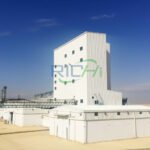As the demand for animal feed continues to grow globally, feed producers are increasingly looking to scale up their operations to meet market needs. A 30 t/h animal feed plant is an attractive option for medium to large-scale producers, offering the capacity to efficiently produce high volumes of feed. However, selecting the right machinery for a 30 t/h plant requires careful consideration of various factors to ensure optimal performance, efficiency, and product quality. This article provides guidance on choosing suitable 30 t/h animal feed plant machinery.
1. Determine Feed Production Requirements
The first step in selecting appropriate machinery is to clearly define the feed production requirements for your 30 t/h plant. Consider factors such as:
- Types of feed: Will you be producing a single type of feed (e.g., poultry feed) or multiple types (e.g., poultry, livestock, aqua feed)?
- Feed formulations: Understand the raw materials and additives required for your feed formulations, as this will impact the choice of equipment.
- Pellet quality specifications: Determine the desired characteristics of the finished pellets, such as size, hardness, and durability.
- Production flexibility: Consider whether you need the ability to easily adjust production to accommodate changes in demand or formulations.

2. Evaluate Machinery Options
With your production requirements in mind, evaluate the various machinery options available for a 30 t/h animal feed plant. Key equipment includes:
- Grinding machines: Hammer mills or roller mills are commonly used for grinding raw materials to the desired particle size.
- Mixing equipment: Horizontal or vertical mixers ensure thorough and uniform blending of ingredients.
- Conditioning systems: Steam conditioners prepare the feed mixture for pelleting by adjusting moisture and temperature.
- Pellet mills: Ring die or flat die pellet mills compress the conditioned mixture into pellets.
- Cooling and drying systems: Coolers and dryers remove excess moisture from the pellets after extrusion.
- Screening equipment: Vibrating screens sort the pellets by size and remove fines.
- Packaging machines: Bagging or bulk loading systems package the finished feed for storage and distribution.
When evaluating machinery, consider factors such as capacity, energy efficiency, ease of maintenance, and durability. Choosing high-quality animal feed milling machine from reputable manufacturers can help ensure reliable performance and minimize downtime.
3. Assess Automation and Control Systems
Incorporating advanced automation and control systems can significantly enhance the efficiency and consistency of a 30 t/h animal feed plant. Look for machinery with features such as:
- Programmable logic controllers (PLCs): PLCs allow for precise control and monitoring of critical process parameters, such as feed rate, temperature, and moisture content.
- Human-machine interfaces (HMIs): HMIs provide operators with an intuitive interface for monitoring and adjusting the production process in real-time.
- Automated material handling: Conveyors, bucket elevators, and other automated systems can streamline the movement of raw materials and finished products through the plant.
Investing in advanced automation can help reduce labor costs, minimize errors, and ensure consistent product quality.
4. Consider Plant Layout and Integration
The layout and integration of equipment within the 30 t/h animal feed plant can impact efficiency and workflow. Work with equipment suppliers and plant designers to optimize the plant layout, considering factors such as:
- Material flow: Ensure a logical and efficient flow of raw materials and finished products through the plant.
- Equipment placement: Position equipment to minimize material handling and transportation distances.
- Expansion potential: Leave room for future expansion or the addition of new equipment as production needs evolve.
Integrating equipment from a single supplier or working with a turnkey solution provider can simplify the installation process and ensure seamless integration of components.
5. Prioritize Safety and Environmental Considerations
When selecting machinery for a 30 t/h animal feed plant, prioritize equipment that meets safety and environmental standards. Look for features such as:
- Dust control systems: Effective dust collection and ventilation systems help maintain a safe and healthy working environment.
- Noise reduction: Choose equipment with low noise levels to minimize the impact on workers and nearby communities.
- Energy efficiency: Selecting energy-efficient equipment can reduce the plant’s environmental footprint and lower operating costs.
Compliance with relevant safety and environmental regulations is essential for the successful operation of a 30 t/h animal feed plant.
6. Evaluate Supplier Support and Services
The quality of supplier support and services can significantly impact the long-term performance and profitability of your 30 t/h animal feed plant. When selecting equipment suppliers, consider factors such as:
- Technical support: Ensure that suppliers offer comprehensive technical support, including installation guidance, operator training, and ongoing maintenance assistance.
- Spare parts availability: Choose suppliers that can provide quick access to critical spare parts to minimize downtime in case of equipment failures.
- Warranty coverage: Look for suppliers that offer robust warranty coverage on their equipment, providing peace of mind and protection against manufacturing defects.
Investing in equipment from suppliers with a proven track record of reliable support and services can help ensure the long-term success of your 30 t/h animal feed plant.
Conclusion
Selecting appropriate machinery for a 30 t/h animal feed plant requires a careful evaluation of production requirements, equipment options, automation capabilities, plant layout, safety and environmental considerations, and supplier support. By prioritizing these factors and working with experienced equipment suppliers, feed producers can build a 30 t/h plant that delivers consistent, high-quality feed while maximizing efficiency and profitability. As the demand for animal feed continues to grow, investing in the right machinery will be essential for maintaining a competitive edge in the market.
For details please contact: feed pellet machine
WhatsApp:86 138 3838 9622
Email:enquiry@richipelletmachine.com


